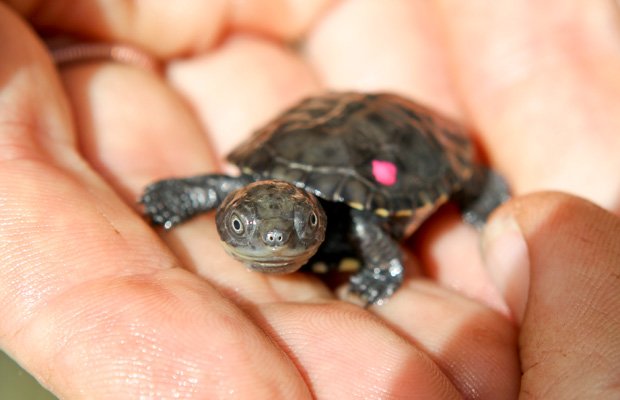Swamp tortoise: Australia’s rarest reptile makes a comeback

THE WESTERN SWAMP TORTOISE has an upturned mouth that resembles a permanent grin – and this endearing little creature may soon have something to really smile about.
As Australia’s rarest reptile – and one of the world’s five rarest turtle and tortoise species – this WA endemic has just reached a conservation milestone. Thirty juvenile tortoises have recently been released into Twin Swamps Nature Reserve, about 35km northeast of Perth, greatly boosting the wild population.
With only 40 mature individuals thought to remain in the wild prior to this, the World Conservation Union (IUCN) had listed the species as critically endangered. The western swamp tortoise (Pseudemydura umbrina) had been feared extinct for over a century until it was rediscovered in 1953 in two small swampy habitats in the Swan Valley.
Western swamp tortoise back from the dead
Since 1987, a successful breeding program at Perth Zoo has seen 570 of the rare tortoises hatched in captivity and released into four sites in the wild.

Adult western swamp tortoise. (Credit: Perth Zoo)
“We release the captives as three-year-olds but it takes another four to six years or more for them to reach sexual maturity,” says zoologist Dr Peter Dawson, head of Perth Zoo’s breeding program. “But they face various threats in the wild and not all make it. They produce only five or six eggs in a clutch, which can be taken by ravens or bandicoots.”
Foxes, rats, feral cats, bushfires and the draining of swamps for agriculture have also taken a heavy toll.
The latest release of captive-bred juveniles isn’t the only good news of late. In December, researchers found one hatchling and one juvenile in Twin Swamps, the first evidence of breeding in the wild since 2003.
“It’s been a very promising couple of years,” says Department of Environment and Conservation (DEC) ecologist Craig Olejnik, who heads WA’s Western Swamp Tortoise Recovery Team.
Captive breeding success for tortoise at Perth Zoo
“In the last fifteen years or so, we’ve been seeing more adults recaptured each year and known to be alive. We’ve got funding for state-of-the-art captive breeding quarters and for feral animal and weed control in the reserves, so we can ensure an optimal environment for them,” Craig told Australian Geographic.
The 12-14cm-long tortoise – actually a kind of freshwater turtle – may even move from the IUCN’s ‘critically endangered’ category to ‘endangered’ status if wild populations increase and the increase can be sustained.
IUCN Red List rules require that at least 50 mature adults must be maintained in the wild for five years before a downgrade in critical conservation status can be made.
Egg laying and hatching of wild tortoises may have been helped by pumps installed in two of four tortoise swamp habitats to keep them moist, since rainfall levels have dropped drastically in south-western Australia.
“We’re trying to optimise the animals’ chance of reproducing in the wild – encouraging them to do it [themselves],” Peter says.
Climate change threat to tortoise
But amid the good news – a new threat looms. Peter says the western swamp tortoise is highly vulnerable to the drier conditions brought by climate change, and Perth has just endured one of the driest Julys on record.
“[It’s] a real threat, because they need reliable rains from June to October to feed up on invertebrates, larvae and tadpoles, during their short five months of activity.” During the drier, hotter months, the tortoise sleeps under leaf litter or in holes, not re-emerging until the following winter.
“We’re now looking at whether it’s possible to relocate tortoises in wetter places further south. But different temperatures or soil types may not suit the tortoise,” Peter says.
RELATED STORIES

